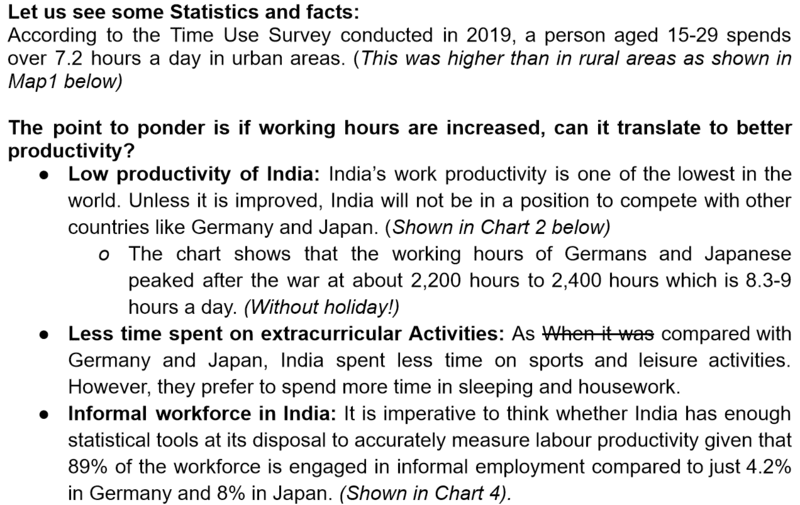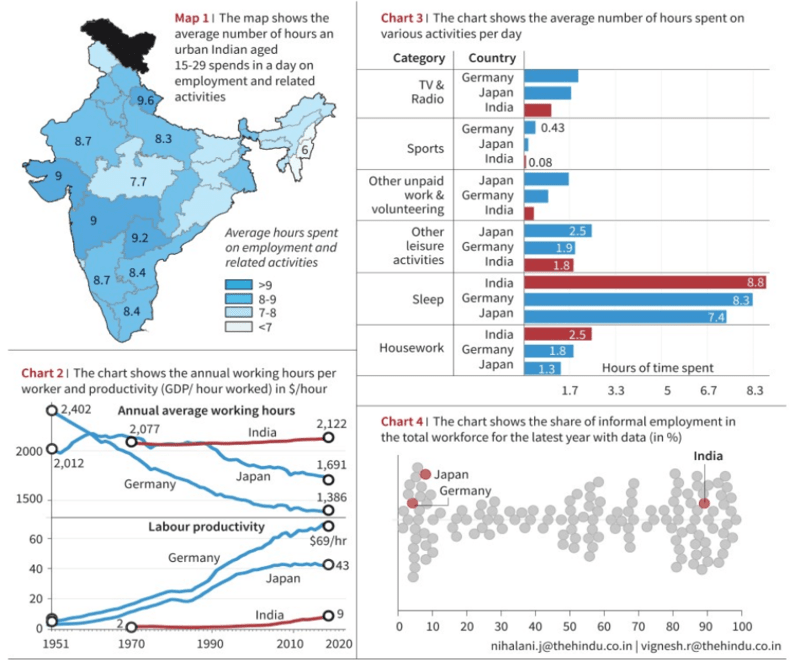Understanding Worker Productivity

Relevance: GS I and II (Social Issues and Justice; Governance)
- Prelims: Productivity and Employment; Demographic dividend and issues;
- Mains: Population issues; Employment and Development issues; International Labour Org.
News Excerpt
To fast-track the country’s development, Infosys founder N. R. Narayana Murthy advised Indians last week to work 70 hours a week.

What is the difference between Worker productivity and Labour productivity?
The primary difference between these two is that the ‘work’ in worker productivity describes mental activities while the ‘work’ in labor productivity is mostly associated with manual activities.
- About Productivity:
- Productivity in a more sophisticated usage is an attribute not of time but of skill.
- Human capital including education, training, nutrition, health, etc., enhances the ability of labour to become more productive or churn out a greater quantum of value within the same number of working hours.
- In certain types of services, especially ones involving intellectual labor, measuring the value of the output independently is very difficult, so the income of workers is usually taken as a proxy to suggest productivity.
- Based on this understanding, the reduction in the number of working hours does not hamper the value of output produced, but in turn enhances the leisure and quality of life of workers in real terms, while the value added to the economy could still be increasing, nominal wages remaining the same.
- Measuring Productivity at different levels:
- At the Micro level: The productivity of activity is usually measured as the quantum of output value per unit of labour (time) cost at a micro level.
- At the Macro level: It is measured in terms of the labour-output ratio or change in Net Domestic Product (NDP) per worker in each sector (where working hours are assumed to be 8 hours per day).


Correlation of Work Productivity and its Impact on Economic Growth in Indian Scenario:
- Direct and indirect relation: An increase in productivity made through any sector affects the value addition or growth in the economy. However, the relationship is quite complex.
- For example, in 1980, India’s Gross Domestic Product was about $200 billion which by 2015 exceeded $2000 billion. However, in terms of the distribution of income across groups in India, it was found that from 1980 to 2015, the share in the national income group and 50% of the low-income group in India had decreased from 48% to 29% and 23% to 14% respectively, the top 10% income groups share had increased from 30% to 58%.
- Patrimonial capitalism in India: The top 0.01% has had an increase of 1699% from 1980-2015 and this top 0.01% of people had an increase of 2040%. Thus, an increase in incomes or the property of the richest people is not quite related to their productivity. On the contrary, this prosperity is linked to hereditary transfers of wealth upon which the rich are earning yields.
Arguments supporting the ’70 hours work per week’ formula:
- Will nurture a disciplined work environment at the workplace: Ethical accountability is the need of the hour. India's work culture needs to undergo a significant shift, and towards becoming highly focused and determined for the growth of the country.
- Lessons from Germany and Japan: Considering the history of both countries, they have improved through many challenges like the World Wars and its impacts. The average annual working hours of Germans and the Japanese peaked after these wars was about 2,200 hours to 2,400 hours a year without holidays.
- Higher Economic Growth: It might boost economic growth as more work hours could contribute to increased production and innovation. It can help India reach the goal of a $5 trillion economy.
- Skill development opportunities: To achieve expertise in a particular subject, investing more time in it becomes a major requirement. Hence, beyond core work areas, if one can set aside more few hours for personal skill enhancement it will result in high quality and high productivity.
Arguments against the ’70 hours work per week’ formula:
- More work hours, less productivity: Productivity has its graph. It is always high at the initial stage however; it consistently shows a decline after some hours of continuous work per week. Thus, the absence of at least one full day off each week can negatively impact overall hourly output.
- Imbalance in Work-life Equilibrium and Arising Health issues in India: Longer working hours result in giving much less time for extra curriculums. Already, Indians spend less time on these activities compared to Germany and Japan. This has led to an increase in Non-communal and cardiac-like diseases. Extended working hours also hinder the body's natural recovery process.
- Triple burden issue of working women: Juggling long hours at work and family responsibilities can hinder career progression for working women. Exhaustive working hours are challenging to manage childcare responsibilities for working mothers. More work does not necessarily translate into more productivity.
Way Forward:
- Need to adapt to the emerging technical environment: Adopting digital technologies and artificial intelligence can streamline many processes. It can reduce manual work and improve work efficiency.
- Awareness for Self-Care is needed: Labors/Employees in India need to make sure to set aside time for personal activities that will help them to relax and rejuvenate, such as exercise, hobbies, and spending time with family.
- Study finds that at least 7-8 hours of quality sleep each night is necessary to ensure the body and mind is stable and recovered from the past.
- Success has no shortcuts: Certainly, hard work is the foundation of success, but it's not just about the working hours put into it, but also about dedication and enthusiasm.
- The goal is to make work fulfilling, allowing a seamless integration of work and personal life. When young professionals are passionate and purpose-driven, achieving work-life harmony becomes a natural outcome
PYQs:
Q1). Besides the welfare schemes, India needs deft management of inflation and unemployment to serve the poor and the underprivileged sections of society. Discuss (2022)
Q2). “While we flaunt India’s demographic dividend, we ignore the dropping rates of employability.” What are we missing while doing so? Where will the jobs that India desperately needs come from? Explain (2014)
Prelims:
Q1). Disguised unemployment generally means (UPSC 2013)
a. Large number of people remains unemployed.
b. Alternative employment is not available
c. Marginal productivity of labor is zero
d. Productivity of workers is low.

